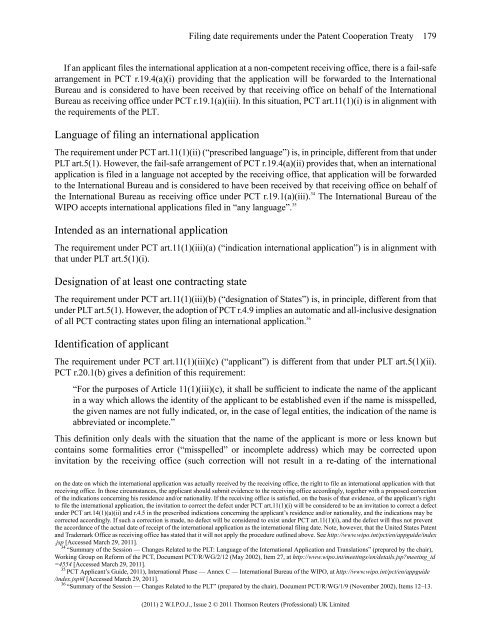WIPO Journal - World Intellectual Property Organization
WIPO Journal - World Intellectual Property Organization
WIPO Journal - World Intellectual Property Organization
You also want an ePaper? Increase the reach of your titles
YUMPU automatically turns print PDFs into web optimized ePapers that Google loves.
If an applicant files the international application at a non-competent receiving office, there is a fail-safe<br />
arrangement in PCT r.19.4(a)(i) providing that the application will be forwarded to the International<br />
Bureau and is considered to have been received by that receiving office on behalf of the International<br />
Bureau as receiving office under PCT r.19.1(a)(iii). In this situation, PCT art.11(1)(i) is in alignment with<br />
the requirements of the PLT.<br />
Language of filing an international application<br />
The requirement under PCT art.11(1)(ii) (“prescribed language”) is, in principle, different from that under<br />
PLT art.5(1). However, the fail-safe arrangement of PCT r.19.4(a)(ii) provides that, when an international<br />
application is filed in a language not accepted by the receiving office, that application will be forwarded<br />
to the International Bureau and is considered to have been received by that receiving office on behalf of<br />
the International Bureau as receiving office under PCT r.19.1(a)(iii). 34 The International Bureau of the<br />
<strong>WIPO</strong> accepts international applications filed in “any language”. 35<br />
Intended as an international application<br />
The requirement under PCT art.11(1)(iii)(a) (“indication international application”) is in alignment with<br />
that under PLT art.5(1)(i).<br />
Designation of at least one contracting state<br />
The requirement under PCT art.11(1)(iii)(b) (“designation of States”) is, in principle, different from that<br />
under PLT art.5(1). However, the adoption of PCT r.4.9 implies an automatic and all-inclusive designation<br />
of all PCT contracting states upon filing an international application. 36<br />
Identification of applicant<br />
Filing date requirements under the Patent Cooperation Treaty 179<br />
The requirement under PCT art.11(1)(iii)(c) (“applicant”) is different from that under PLT art.5(1)(ii).<br />
PCT r.20.1(b) gives a definition of this requirement:<br />
“For the purposes of Article 11(1)(iii)(c), it shall be sufficient to indicate the name of the applicant<br />
in a way which allows the identity of the applicant to be established even if the name is misspelled,<br />
the given names are not fully indicated, or, in the case of legal entities, the indication of the name is<br />
abbreviated or incomplete.”<br />
This definition only deals with the situation that the name of the applicant is more or less known but<br />
contains some formalities error (“misspelled” or incomplete address) which may be corrected upon<br />
invitation by the receiving office (such correction will not result in a re-dating of the international<br />
on the date on which the international application was actually received by the receiving office, the right to file an international application with that<br />
receiving office. In those circumstances, the applicant should submit evidence to the receiving office accordingly, together with a proposed correction<br />
of the indications concerning his residence and/or nationality. If the receiving office is satisfied, on the basis of that evidence, of the applicant’s right<br />
to file the international application, the invitation to correct the defect under PCT art.11(1)(i) will be considered to be an invitation to correct a defect<br />
under PCT art.14(1)(a)(ii) and r.4.5 in the prescribed indications concerning the applicant’s residence and/or nationality, and the indications may be<br />
corrected accordingly. If such a correction is made, no defect will be considered to exist under PCT art.11(1)(i), and the defect will thus not prevent<br />
the accordance of the actual date of receipt of the international application as the international filing date. Note, however, that the United States Patent<br />
and Trademark Office as receiving office has stated that it will not apply the procedure outlined above. See http://www.wipo.int/pct/en/appguide/index<br />
.jsp [Accessed March 29, 2011].<br />
34<br />
“Summary of the Session — Changes Related to the PLT: Language of the International Application and Translations” (prepared by the chair),<br />
Working Group on Reform of the PCT, Document PCT/R/WG/2/12 (May 2002), Item 27, at http://www.wipo.int/meetings/en/details.jsp?meeting_id<br />
=4554 [Accessed March 29, 2011].<br />
35<br />
PCT Applicant’s Guide, 2011), International Phase — Annex C — International Bureau of the <strong>WIPO</strong>, at http://www.wipo.int/pct/en/appguide<br />
/index.jsp#I [Accessed March 29, 2011].<br />
36<br />
“Summary of the Session — Changes Related to the PLT” (prepared by the chair), Document PCT/R/WG/1/9 (November 2002), Items 12–13.<br />
(2011) 2 W.I.P.O.J., Issue 2 © 2011 Thomson Reuters (Professional) UK Limited

















